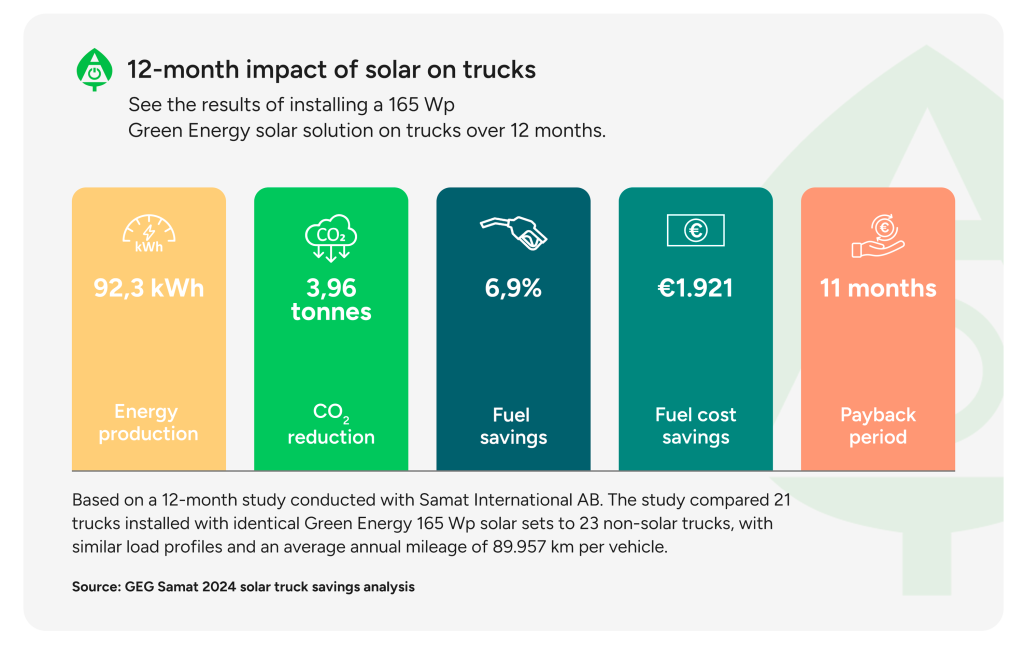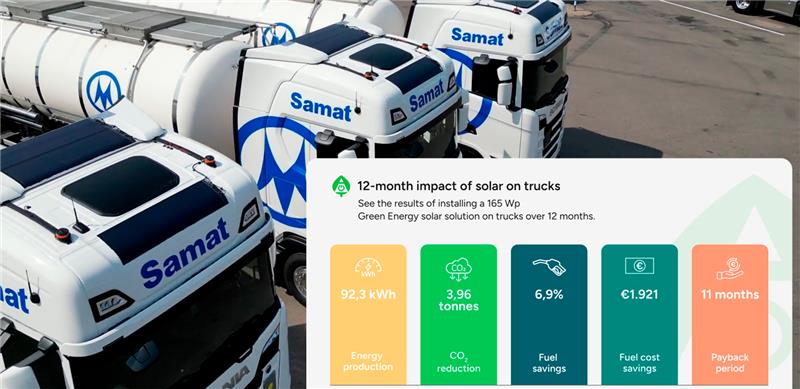Our latest data from a year-long study with Samat International AB provides compelling evidence that solar on trucks is not just a concept – it’s a proven solution
With the arrival of spring, now is the perfect time to talk about solar. After a full year of data collection, we’re delighted to share the results of a comparative study with Samat International AB, one of Europe’s leading logistics companies. The results are clear: Green Energy solar systems deliver real value, both environmentally and financially.
From Pilot to Proof – and Payback
Following a successful pilot in 2023, this extended study tracked the performance of 44 trucks over 12 months: 21 equipped with identical Green Energy 165 Wp solar panels and 23 standard diesel trucks as a control group. The fleet, consisting of Scania and Volvo trucks, carried similar loads, covered an average annual mileage of 89.957 km per truck, and operated under comparable conditions and routes throughout 2024.
Here’s what we found. The solar-powered trucks achieved:
- 6,9% average annual fuel savings
- 1.478 litres of diesel saved per truck per year
- 92,3 kWh of solar energy produced per vehicle
- €1.921 annual fuel cost saving per truck
- 3,96 tonnes of CO₂ emissions avoided per truck per year
That’s a payback period of just 11 months from the fuel savings alone!
But that’s not all. Our solar solution also has a positive effect on operational efficiency. Samat and other customers report significant reductions in idling time, in turn reducing unnecessary fuel consumption, extending battery and alternator life, and lowering operating costs. They also report fewer battery-related breakdowns and callouts, reducing downtime and cost.

A scalable solution for every fleet
With rising fuel prices, ambitious sustainability goals and tightening regulatory requirements, fleet owners are under increasing pressure to reduce costs and emissions without compromising operations. The results of this study confirm that solar offers a simple, scalable solution. Our solar panels provide transport companies with a transitional technology that makes an immediate impact on emissions and fuel efficiency at a small fraction of the investment cost. It works reliably in real-world conditions, requires no changes to routes or fueling infrastructure, and delivers payback in less than a year.
Samat was so happy with the results that so far in 2025, they have installed 20 brand new DAF trucks with our solar systems from Day 1.
While this study focused on long-haul trucks, our solar systems can be installed on almost any type of vehicle – helping fleets of all sizes to cut fuel consumption, reduce maintenance needs and meet environmental goals with minimal disruption.
Are you ready to bring solar savings to your fleet?
Join the leaders in sustainable transport – start saving fuel and lowering CO₂ today. Contact: sales@greenenergy.pro
Can you afford to wait?
Read more about our solar solution here.
Download the Samat data here.










